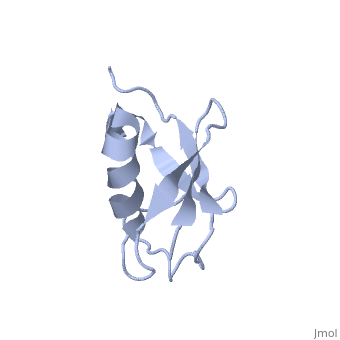1v80
From Proteopedia
Solution structures of ubiquitin at 30 bar and 3 kbar
Structural highlights
FunctionUBC_BOVIN Ubiquitin: Exists either covalently attached to another protein, or free (unanchored). When covalently bound, it is conjugated to target proteins via an isopeptide bond either as a monomer (monoubiquitin), a polymer linked via different Lys residues of the ubiquitin (polyubiquitin chains) or a linear polymer linked via the initiator Met of the ubiquitin (linear polyubiquitin chains). Polyubiquitin chains, when attached to a target protein, have different functions depending on the Lys residue of the ubiquitin that is linked: Lys-6-linked may be involved in DNA repair; Lys-11-linked is involved in ERAD (endoplasmic reticulum-associated degradation) and in cell-cycle regulation; Lys-29-linked is involved in lysosomal degradation; Lys-33-linked is involved in kinase modification; Lys-48-linked is involved in protein degradation via the proteasome; Lys-63-linked is involved in endocytosis, DNA-damage responses as well as in signaling processes leading to activation of the transcription factor NF-kappa-B. Linear polymer chains formed via attachment by the initiator Met lead to cell signaling. Ubiquitin is usually conjugated to Lys residues of target proteins, however, in rare cases, conjugation to Cys or Ser residues has been observed. When polyubiquitin is free (unanchored-polyubiquitin), it also has distinct roles, such as in activation of protein kinases, and in signaling (By similarity). Evolutionary ConservationCheck, as determined by ConSurfDB. You may read the explanation of the method and the full data available from ConSurf. Publication Abstract from PubMedConformational fluctuation plays a key role in protein function, but we know little about the associated structural changes. Here we present a general method for elucidating, at the atomic level, a large-scale shape change of a protein molecule in solution undergoing conformational fluctuation. The method utilizes the intimate relationship between conformation and partial molar volume and determines three-dimensional structures of a protein at different pressures using variable pressure NMR technique, whereby NOE distance and torsion angle constraints are used to create average coordinates. Ubiquitin (pH 4.6 at 20 degrees C) was chosen as the first target, for which structures were determined at 30 bar and at 3 kbar, giving "NMR snapshots" of a fluctuating protein structure at atomic resolution. The result reveals that the helix swings in and out by >3 angstroms with a simultaneous reorientation of the C-terminal segment, providing an "open" conformer suitable for enzyme recognition. Spin relaxation analysis indicates that this fluctuation occurs in the ten microsecond time range with activation volumes -4.2(+/-3.2) and 18.5(+/-3.0) ml/mol for the "closed-to-open" and the "open-to-closed" transitions, respectively. NMR snapshots of a fluctuating protein structure: ubiquitin at 30 bar-3 kbar.,Kitahara R, Yokoyama S, Akasaka K J Mol Biol. 2005 Mar 25;347(2):277-85. PMID:15740740[1] From MEDLINE®/PubMed®, a database of the U.S. National Library of Medicine. See AlsoReferences
| ||||||||||||||||||


